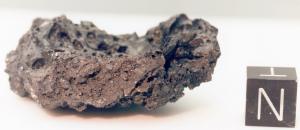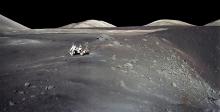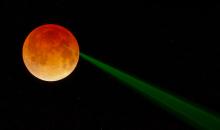This ordinary looking rock is one of the most precious rocks on Earth: a piece of the Moon. It was blasted into space when an asteroid hit the Moon. It later fell to Earth in Antarctica, where it was discovered in 1994. It weighs less than an ounce. For reference, the cube is one centimeter (0.4 inch) wide. [NASA]
You are here
Lunar Meteorites
Apollo astronauts brought about 840 pounds of lunar rocks and dirt back to Earth. Most of those samples are locked away in laboratories and vaults, while a few more are displayed in museums.
Many other moonrocks are simply scattered across the ground. It’s possible that you’ve walked past one, or even picked one up. But it takes an expert — and one of those laboratories — to confirm its origin.
These moonrocks are meteorites — bits of the Moon blasted into space when an asteroid slammed into the lunar surface. Some of the debris from such an impact enters Earth’s atmosphere. Pieces that are big enough hit the ground.
Scientists have cataloged hundreds of lunar meteorites. But it’s not easy. Most lunar meteorites look like Earth rocks. So it takes a detailed analysis to confirm their lunar origin.
Scientists examine the rock’s chemical and mineral composition. They look for evidence that it’s been zapped by cosmic rays, which are blocked by Earth’s atmosphere. And they look at the ratios of different forms of certain elements, which are different for the Moon than for Earth or other bodies.
Lunar meteorites tend to be found where all meteorites are common — deserts where there are few Earth rocks — places where pieces of the Moon can hide in plain sight.
And the Moon itself is in plain sight this evening. It’s in the southwest at nightfall, with the bright star Antares, the heart of the scorpion, to its lower left.
Script by Damond Benningfield
Get Premium Audio
Listen to today's episode of StarDate on the web the same day it airs in high-quality streaming audio without any extra ads or announcements. Choose a $8 one-month pass, or listen every day for a year for just $30.






